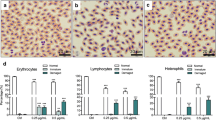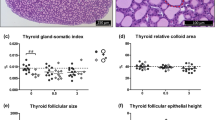Abstract
Chronic treatment with inorganic lead (Pb) has been shown to increase the proportion of arachidonic acid (ArA), as well as the arachidonate/linoleate (ArA/LA) ratio, in the fatty acids of lipids from a variety of avian tissues. Changes in two fatty acid-mediated phenomena, peroxidation of membrane lipids and synthesis of eicosanoid cytokines, are associated with this enhanced ArA content. The authors are not aware of any reports in the literature in which these effects of Pb have been described for any animals other than birds. In the current study, the authors investigated the effect of Pb on lipid metabolism in three species: avian, rodent, and human. The group of children identified as suffering environmental Pb exposure were from a Pb-surveillance program and had blood Pb concentrations (PbB) averaging 23 μg/dL. Turkey poults fed 100 ppm dietary Pb as Pb acetate-trihydrate for 19 d had a PbB of 46 μg/dL. Gastric intubation of rats with 80 mg Pb/kg/d for 10 d resulted in a PbB of 74 μg/dL. We analyzed fatty acid composition of whole blood from children, poults, and virgin rats. Low-dose (nongrowth inhibitory) Pb exposure resulted in significantly increased ArA concentration and ArA/LA ratio in blood from all species. Also analyzed were plasma and liver of poults, virgin rats, and pregnant rats and their fetuses. In plasma and liver from Pb-treated poults and virgin rats, ArA and the ArA/LA ratio were again enhanced. Pb intoxication also affected ω3 composition, increasing the concentrations of all long-chain ω3 fatty acids of fetuses from Pb-treated pregnant dams. The authors propose that altered fatty acid metabolism may be responsible for some indications of Pb poisoning. Possible consequences mediated through lipid peroxidation and production of ArA-derivative eicosanoids are considered.
Similar content being viewed by others
References
G. W. Goldstein,Neurotoxicology 14, 97–102 (1993).
T. J. B. Simons,Neurotoxicology 14, 77–86 (1993).
M. A. Verity,Environ. Health. Perspect. 89, 43–18 (1990).
H. G. Petering, inTrace Element Metabolism in Animals-II, W.G. Hoekstra, ed., University Park Press, Baltimore, pp. 311–325 (1974).
W. E. Donaldson and T. K. Leeming,Toxicol. Appl. Pharmacol. 73, 119–123 (1984).
W. E. Donaldson,Biol. Trace Element Res. 7, 255–262 (1985).
L. J. Lawton and W. E. Donaldson,Biol. Trace Element Res. 28, 83–97 (1991).
A. L. Tappel,Arch. Biochem. Biophys. 50, 473–485 (1954).
J. F. Mead, inFree Radicals in Biology: vol.1, W. A. Pryor, ed., Academic, New York, pp. 51–68 (1976).
M. Chvapil, J. N. Ryan, and Z. Brada,Biochem. Pharmacol. 21, 1097–1105 (1972).
O. A. Levander, V. C. Morris, and R. J. Ferretti,J. Nutr. 107, 2135–2143 (1977).
S. J. Stohs and D. Bagchi,Free Radical Biol. Med. 18, 321–336 (1995).
M. Hermes-Lima, B. Pereira, and E. J. H. Bechara,Xenobiotica 21, 1085–1090 (1991).
S. J. Yiin and T. H. Lin,Biol. Trace Element Res. 50, 167–172 (1994).
M. M. Mathias and J. Dupont,Lipids 20, 791–301 (1985).
J. E. Kinsella, K. S. Broughton, and J. Whelan,J. Nutr. Biochem. 1, 123–141 (1990).
A. Käfer, H. Zältze, and H. F. Krug,Toxicol. Appl. Pharmacol. 116, 125–132 (1992).
S. O. Knowles and W. E. Donaldson,Comp. Biochem. Physiol. 95C, 99–104 (1990).
Chemical & Environmental Technology, Inc., Environmental Laboratory and Consulting Services, RTP, NC 27709.
National Research Council,Nutrient Requirements of Poultry, Natl. Acad. Sci., Washington, DC. (1984).
P. W. Parks and R. E. Goins,J. Food Sci. 59, 1262–1266 (1994).
J. Folch, M. Lees, and G. H. S. Stanley,J. Biol. Chem. 226, 477–480 (1957).
SAS Institute,SAS User’s Guide: Statistics, SAS Institute, Inc., Cary, NC (1987).
L. D. Grant, C. A. Kimmel, G. L. West, C. M. Martinez-Vargas, and J. L. Howard,Toxicol. Appl. Pharmacol. 56, 42–58 (1980).
P. B. Hammond and P. A. Succop,Toxicol. Appl. Pharmacol. 131, 80–84 (1995).
United States Department of Health and Human Services, Centers for Disease Control,Preventing lead poisoning in young children, CDC, Atlanta (1991).
National Research Council,Measuring Lead Exposure in Infants, Children, and Other Sensitive Populations, Natl. Acad. Sci., Washington, DC (1993).
K. Terayama,Ind. Health 31, 113–126 (1993).
P. Lopez-Luna, I. Maier, and E. Herrera,Biol. Neonate 60, 29–38 (1991).
R. J. Bull, P. T. McCauley, D. H. Taylor, and K. M. Croften,Neurotoxicology 4, 1–18 (1983).
British Nutrition Foundation Task Force, inUnsaturated Fatty Acids: Nutritional and Physiological Significance, Chapman & Hall, London, pp. 63–67 (1992).
K. S. Bjerve, S. Fischer, and K. Alme,Am. J. Clin. Nutr. 46, 570–576 (1987).
H. S. Hansen,Nutr. Rev. 52, 162–167 (1994).
W. E. Connor, M. Neuringer, and S. Reisbick,Nutr. Rev. 50, 21–29 (1992).
A. C. Fogerty, G. L. Ford, I. E. Dreosti, and I. J. Tinsley,Nutr. Rep. Int. 32, 1009–1019 (1985).
P. Mushak and A. F. Crocetti,Environ. Res. 50, 211–229 (1989).
J. J. Chisolm,Dev. Med. Child. Neurol. 7, 529–536 (1965).
M. Peck, E. Mantero-Atienza, M. J. Miguez-Burbano, M. A. Fletcher, G. Shor-Posner, and M. K. Baum,Lipids 28, 593–597 (1993).
Author information
Authors and Affiliations
Rights and permissions
About this article
Cite this article
Knowles, S.O., Donaldson, W.E. & Andrews, J.E. Changes in fatty acid composition of lipids from birds, rodents, and preschool children exposed to lead. Biol Trace Elem Res 61, 113–125 (1998). https://doi.org/10.1007/BF02784024
Received:
Accepted:
Issue Date:
DOI: https://doi.org/10.1007/BF02784024




